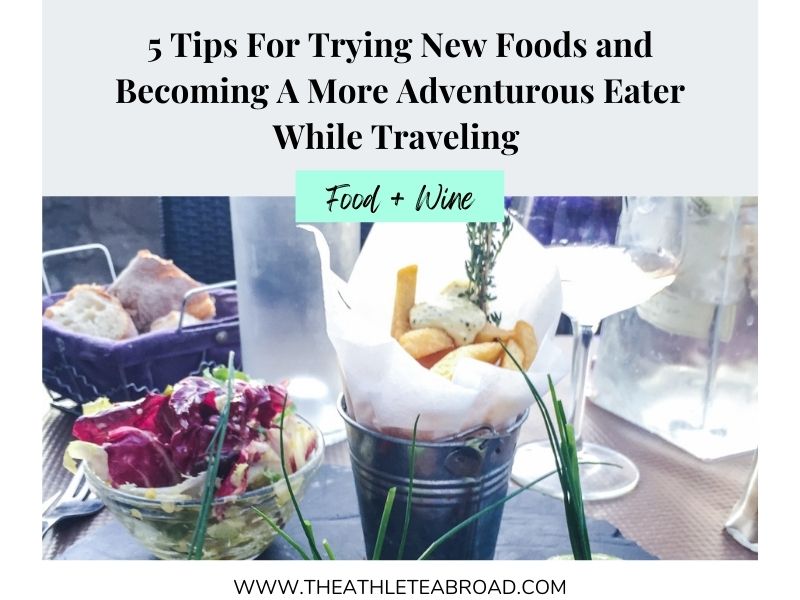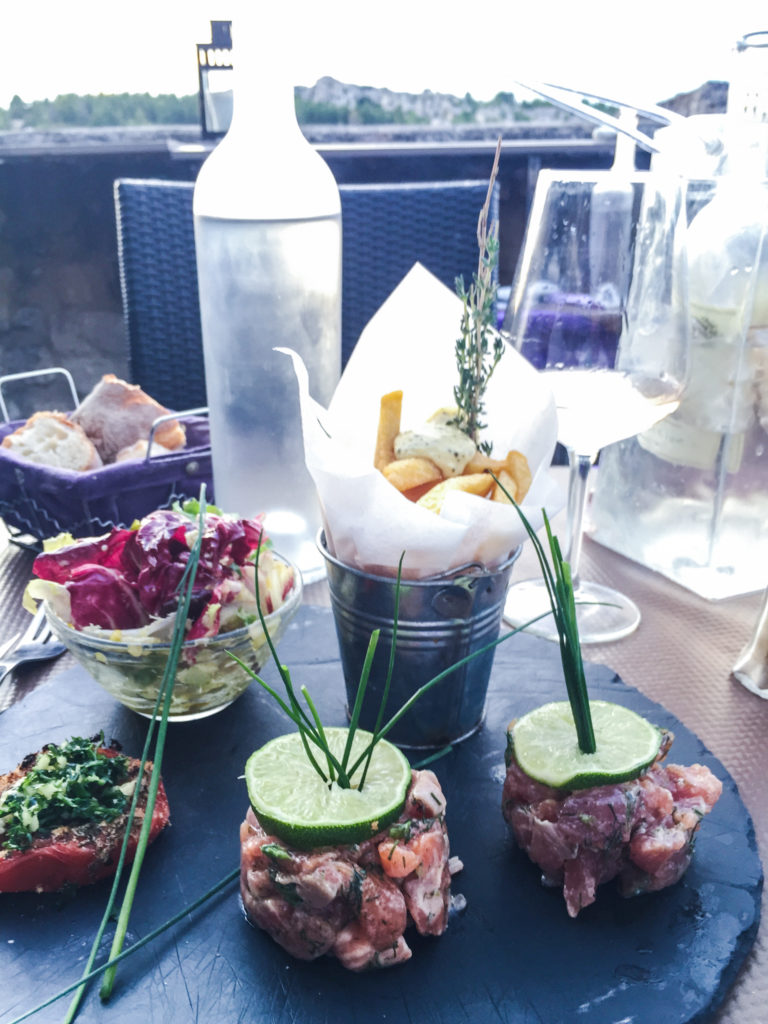5 Tips For Trying New Foods and Becoming A More Adventurous Eater While Traveling

Are you interested in trying new foods when you travel, but not sure where to start?
I have always loved food since I was a kid, but was not always someone you would consider to be an adventurous eater. My parents exposed my siblings and I to some unusual foods growing up, but I mostly knew what I liked and would eat for fuel and enjoyment but with health and fitness in mind, while never actively trying new foods or seeking to expand my palette.
Nowadays I consider myself to be a foodie and a fearless eater who actively seeks out opportunities to taste new foods and experience life through flavor. My motto is that I’ll try just about anything once.
You may be wondering how exactly that change happened for me. Well, It wasn’t until I moved to Europe and got exposed to European foods that I became curious and truly excited about food in a way I never had been before. Traveling frequently and living in another country made trying new foods normal and a part of everyday life, although I have to admit it wasn’t love at first sight.
The first time I ate at a restaurant in Europe, I tried to order something that seemed familiar enough- pizza with salmon. When my meal arrived with salmon fumé (smoked salmon) atop my pizza, I was taken aback. I expected grilled salmon and instead I got this. I had always avoided sushi back home, thinking eating it would make me sick, and was convinced that eating this pizza would be no different. I didn’t understand how some of my basketball teammates ordered the same dish and were happily enjoying every bite. I sucked up my fear, made it through without getting sick and actually ended up enjoying it. Looking back, I’m embarrassed I was so horrified by something as tasty and delightful as salmon fumé, but this experience was mere hours after arriving on the European continent for the first time, and I realize now just how much I didn’t know then.
The best thing that ever happened to me with food was my daily lunch stipend during that first year in Europe.
One of my club’s sponsors was a local French restaurant in the city center. The French owner and chef would speak to me en français and offer me two options for lunch each day when I came in – the plat du jour #1 or the plat du jour #2. Although I would typically extract a word or two of what the dish might contain while putting my high school French to the test, I never really knew what I was getting myself into. Every meal that was put in front of me was a surprise, so I would either eat it, or wouldn’t be having lunch that day. In much of Europe lunch is the biggest meal of the day, so these were not just sandwiches and salads. These were flavorful, elegant, and wonderfully prepared French meals, and there was no way I was going to let fear get in my way of experiencing them.
There were certainly some days that I doubted my ability to consume what came before me, but my pride got in the way, and never let me down. During the course of that year, I tried a new meal every single day and ate some of the best food I’ve ever had. Trying new foods became a daily habit, and my world was opened up to European foods and some of the very best foods in Europe. I fell in love with French cuisine, realized a passion for cooking and came to understand that when you step outside of your comfort zone, you will be rewarded.
Trying new foods when traveling allows you to get a glimpse into another culture at a very human level. Many of my favorite European foods would not have been things I would have initially sought out, but I’ve made an effort to regularly try new and different things when I travel versus always going for the favorites that I know and love.

Here are my top 5 tips for trying new foods so you too can become an adventurous eater.
1. Start With Street Food
Rather than experimenting at a nice restaurant where you might shell out a lot of money for something you don’t love, or embarrass yourself with your lack of ability to eat the food properly, street food is the way to go. This is a low pressure situation. If you don’t like what you’ve tried you uaren’t losing out on too much.
2. Observe the Locals
Local cuisine can sometimes be intimidating just by outward appearance. If you’ve never tried escargot (snails), percebes (gooseneck barnacles) or prawns in the shell you might not even know where to begin and that might stop you from ever trying them in the first place. Trust me, I’ve been there. I used to avoid such foods for fear of embarrassing myself or offending someone, but in reality I was only allowing myself to miss out on some of the best foods.
You can learn a lot from observing locals, and this is the strategy I employ today whenever I am in a restaurant in an unfamiliar place. I not only observe how locals eat, but I also observe how they order. Rather than scrolling through my phone, I carefully pay attention to those around me, watching which utensils they use to attack an unusual food, or which item everyone seems to be getting, as this is often indicates the best items on the menu. Observing locals helps you discover some secret dishes you may not have otherwise encountered, but also is a good way to figure out the right way to actually eat new things and also navigate local customs and manners. By observing locals, you’ll often find the best food and the most authentic experience.
3. Make Small Changes at First
Changing any habit can be difficult, so it’s best to start small if you want to be successful. When you are traveling, challenge yourself to try one new drink, one appetizer, or a favorite dish that’s prepared in a different way than you are used to having it at home. These small steps allow you to get a taste for something new without a total shock to the system. Once these small food experiments become a habit, it will become easier to step out of your comfort zone and try new foods regularly.
4. Eat Tapas or Family Style
One of my favorite things about Spain and Portugal is the way they eat. Tapas is the name of the game, and little plates are abundant. Eating tapas allows you to try small amounts of lots of different types of foods. Small plates that are relatively inexpensive make the barrier to entry quite low. You might be able to get one small piece of bread with an unusual spread or fish on top. Since plates are usually bite sized, anything you don’t love won’t result in significant food waste and chances are you’ll find plenty of things you do like through this experiment of trial and error. Menus are not always in English and if you don’t have some language basics, you might be guessing sometimes, but it’s always worth it and a perfect way to step out of your comfort zone and explore new foods while traveling.
If you are not in a country that features tapas, take every opportunity you can to share meals and order family style, especially when traveling with others. Sharing several plates is one of my favorite ways to eat in general, but is also one of the easiest ways you can start experimenting with new foods with low risk. This is a lot like tapas, however a way for you to incorporate the tapas-mentality in places that don’t normally eat that way.
5. Talk to Locals to Better Understand the Food Culture and Customs
Although it’s not always easy due to language barriers, I talk to locals about food whenever I have the opportunity to do so. I’ve found that when I know a story behind the food, the source, what went into preparing a meal, or what a special meal signifies to the local people, I am much more likely to embrace it myself. I encourage you to ask questions about what you are eating, and you might just fall in love with it as much as the chef has. My favorite way to enjoy food is in someone’s home, learning about their special recipes, traditions and what matters most to them. Some of my favorite travel stories have come from sitting around the dinner table in another country. Even if you don’t know any locals and are traveling alone, you can connect with others on the street, in shops, in restaurants. If you show a respect for local culture are willing to try something new, you’ll find locals open up in ways you never imagined.
The more I travel, the more adventurous I want to be with food.
I’ve discovered some of the best foods while traveling and have found that it’s not just about the food, it’s the window into the soul of the local community that keeps me coming back for more.
Food is not just food. It connects us with one another, breaks down barriers, and tells a story. It’s truly an experience and an event in itself. Every bite is enjoyed, every taste is savored, and every moment shared together. The relationship with and respect for food is one of the things I love most about Europe. This has transformed my experience with food from being adventurous, to simply loving the experience and the joy food brings.
LEAVE A COMMENT